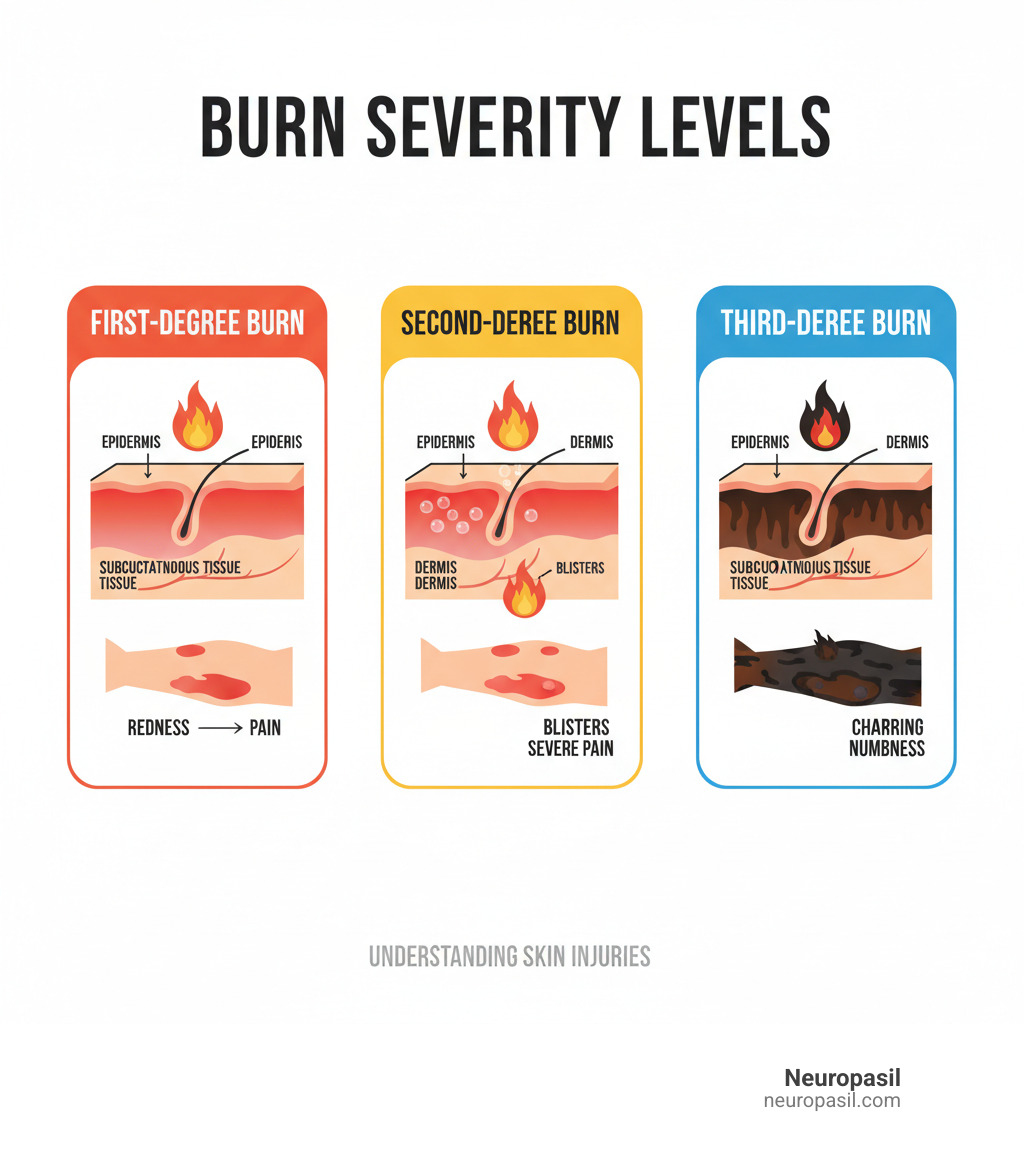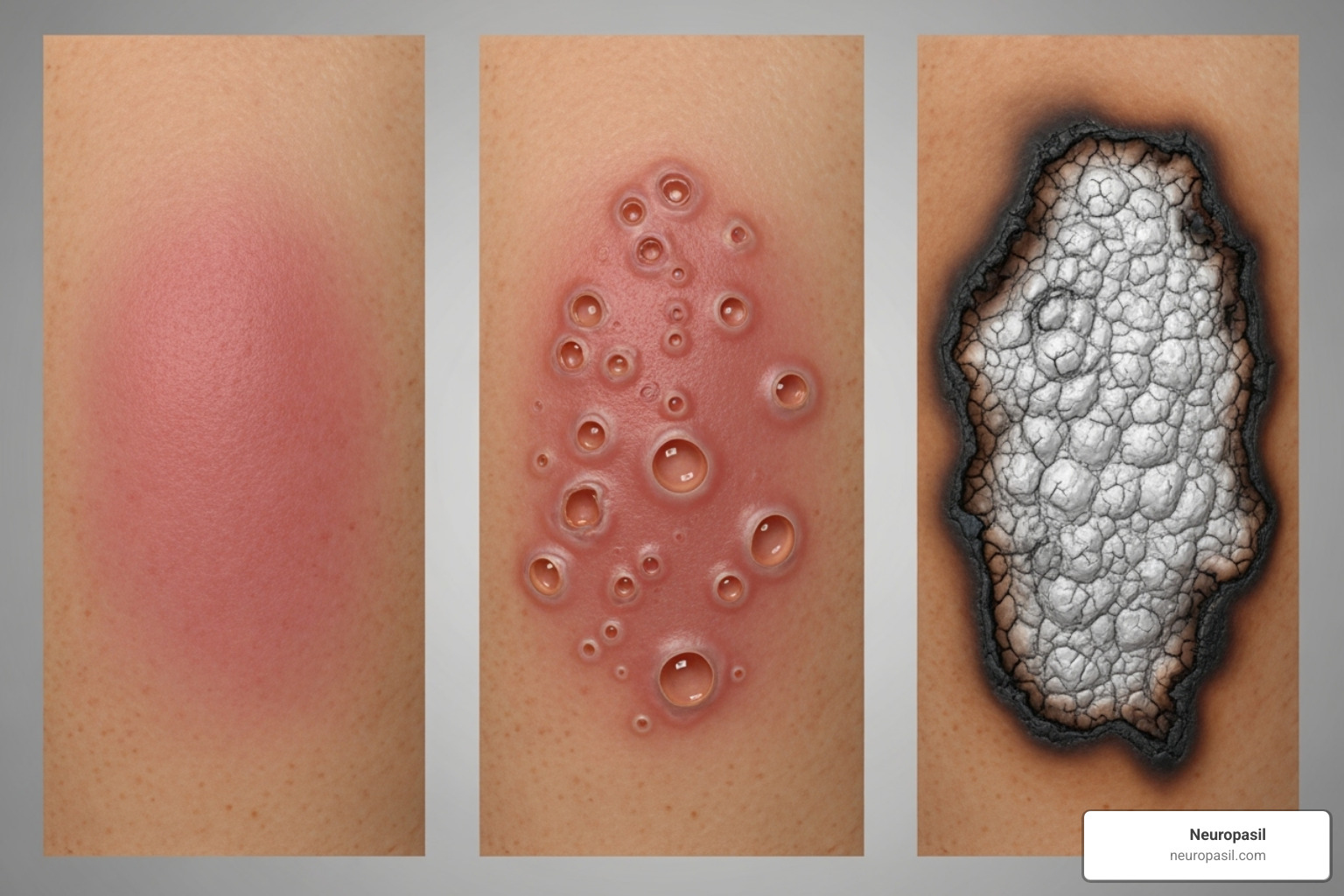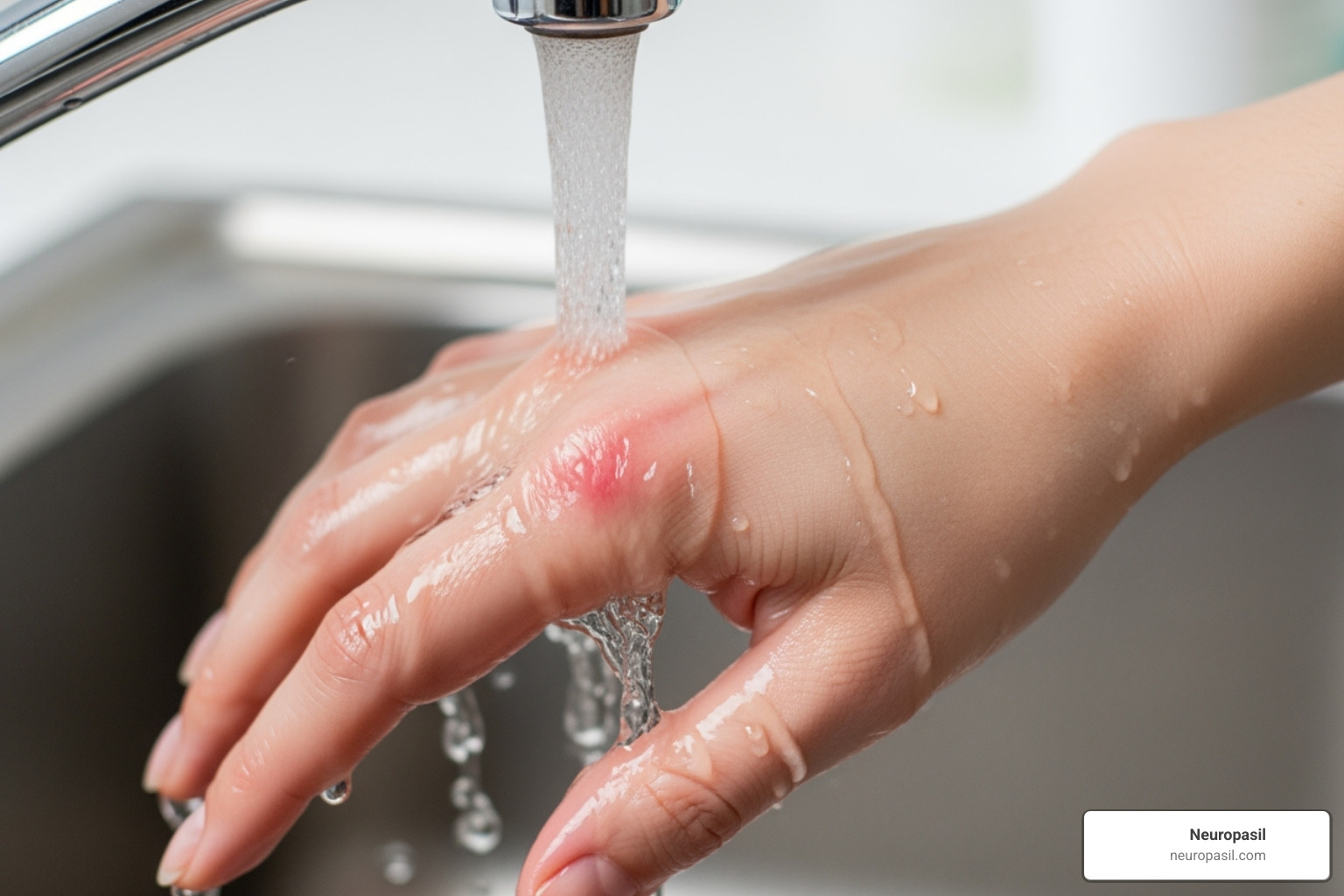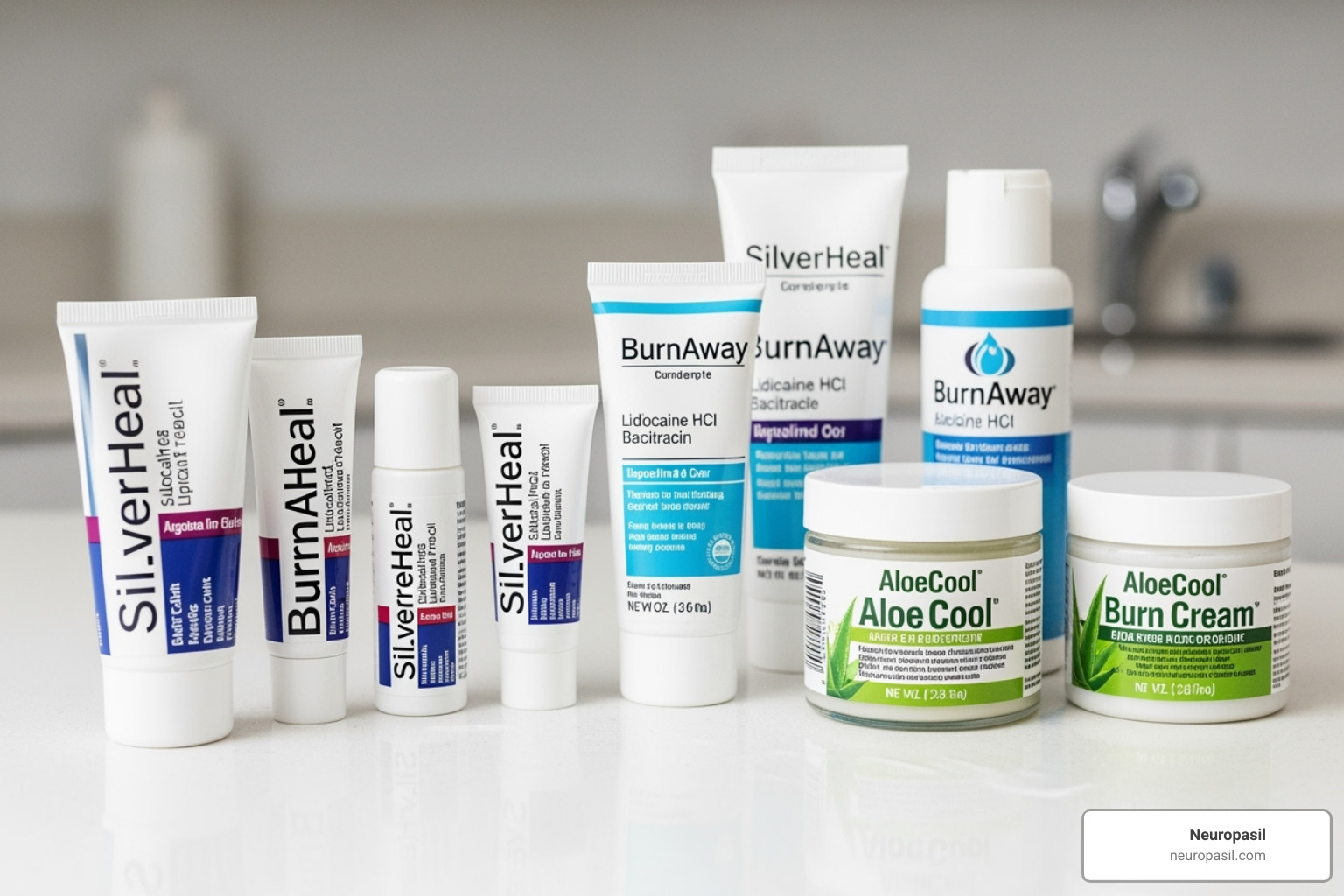Why Quick Action Matters When You Need a Cream for Burning
Cream for burning situations requires immediate attention and the right treatment approach. Whether you're dealing with a kitchen accident, sunburn, or minor thermal injury, knowing what to apply and when can make the difference between quick healing and prolonged discomfort.
Quick Reference for Burn Treatment:
- First-degree burns: Cool water + aloe vera or petroleum jelly
- Second-degree burns: Cool water + antibiotic cream + sterile dressing
- Third-degree burns: Seek immediate medical attention
- Never use: Ice, butter, oils, or egg whites
- When to see a doctor: Burns larger than 2 inches, signs of infection, or burns on face/hands
Burns happen fast, but your response doesn't have to be panicked. The first 15 minutes after a burn occurs are critical - this is when you can stop the burning process and minimize tissue damage. Research shows that for many second-degree burns, proper home treatment is all that's needed for healing and preventing complications.
The key is understanding what type of burn you're dealing with and choosing the right treatment. Minor burns can take up to 3 weeks to heal, but with proper care including the right cream for burning relief, you can reduce pain, prevent infection, and minimize scarring.
From antibiotic creams like silver sulfadiazine for serious burns to natural options like aloe vera for minor injuries, different situations call for different approaches. Some people also experience burning sensations related to nerve issues, which require specialized care beyond typical burn treatment.

Understanding Burn Types and Severity

Not all burns are created equal, and that's actually good news for most of us. The difference between a minor kitchen mishap and a serious medical emergency often comes down to how deep the burn goes into your skin. Understanding these differences helps you make smart decisions about treatment - including whether you need a cream for burning relief or a trip to the emergency room.
Your skin is like a three-layer cake, and burns are classified by how many layers they affect. The epidermis sits on top, acting as your body's protective barrier. Underneath lies the dermis, packed with nerve endings, blood vessels, and hair follicles. The deepest layer, called subcutaneous tissue, contains fat and connective tissue that cushions your muscles and bones.
When you're doing your initial assessment, take a moment to look at the burn carefully. The appearance, pain level, and presence of blisters will tell you almost everything you need to know about severity.
First-Degree Burns (Superficial)
Think sunburn, and you've got the perfect example of a first-degree burn. These surface-level injuries only damage the outermost skin layer, leaving you with that familiar redness and minor pain that makes you wince when someone pats your shoulder.
The good news? No blisters appear with first-degree burns, and they typically heal within a week without leaving scars. Your skin might peel a bit (just like after a day at the beach), but that's completely normal.
For treatment, your best friend is cool water - run it over the burn for 10 to 15 minutes to stop the burning process. Once you've cooled things down, soothing lotions like aloe vera work wonders. The gel from an aloe plant is particularly effective, though store-bought versions work fine too.
Second-Degree Burns (Partial Thickness)
Here's where things get more serious. Second-degree burns punch through that top layer and damage the dermis underneath. The telltale sign? Blisters - those fluid-filled bubbles that your body creates to protect the damaged tissue beneath.
These burns bring severe pain because they've reached your nerve endings, and you'll likely see significant swelling around the affected area. The skin often looks red and splotchy, sometimes with a wet or shiny appearance.
The healing time for second-degree burns typically ranges from 2 to 3 weeks, and many smaller ones are perfectly suitable for home treatment. The key is keeping them clean and protected while your body does its repair work.
Third-Degree Burns (Full Thickness)
This is when you need to put down any cream for burning and pick up the phone to call for help. Third-degree burns destroy all skin layers, sometimes reaching fat, muscle, or bone underneath.
Surprisingly, these burns often cause numbness rather than pain because they've destroyed the nerve endings. The skin takes on a charred appearance, or it might look white or waxy - definitely not what healthy skin should look like.
The nerve damage from third-degree burns means you might not feel the full extent of the injury right away. This is exactly why they require immediate medical attention - the damage is far more extensive than what you can see or feel on the surface.
Never attempt home treatment for third-degree burns. These injuries carry serious risks of infection, severe scarring, and life-threatening complications that only medical professionals can properly address.
Immediate First Aid and Home Care for Minor Burns

When you've just burned yourself, your heart might be racing and the pain feels overwhelming. Take a deep breath - you've got this. The next few minutes are important, but with the right approach, you can significantly reduce both pain and long-term damage. Our goal is simple: reduce pain, prevent infection, and set the stage for proper healing with the right cream for burning.
The First 15 Minutes: Critical First Aid
Those first few minutes after a burn aren't just about immediate relief - they're actually stopping the burning process that's still happening under your skin. Think of it like turning off a stove that's still hot.
Cool water is your best friend right now. Run cool (not ice-cold) tap water over the burn for at least 10 to 15 minutes. Yes, it might feel like forever when you're in pain, but research shows that rinsing for 15 to 30 minutes can effectively stop the pain and prevent deeper tissue damage. The cool water literally lowers your skin temperature and stops the burn from getting worse.
Here's something important: skip the ice completely. I know it seems logical, but ice can actually cause more damage to your already injured skin.
Remove jewelry and tight clothing quickly - especially rings, watches, or anything around the burned area. Swelling happens fast with burns, and you don't want jewelry cutting off circulation later.
For gentle cleaning, wash the area with mild soap and water, but only after you've cooled it thoroughly. If chemicals caused the burn, get any contaminated clothing off immediately. Always wash your hands first before touching the burn - the last thing you want is to introduce bacteria to an open wound.
How to Properly Apply a Cream for Burning
Once you've handled the immediate emergency, it's time to think about healing. Applying a cream for burning properly can make the difference between quick recovery and prolonged discomfort.
Start with clean hands - this can't be emphasized enough. Wash thoroughly with soap and water before touching the burn or any cream.
Clean the burn area gently with mild soap and water, then pat (don't rub) it dry with a clean cloth or sterile gauze. Rubbing irritated skin is like sandpaper on a sunburn - it just makes everything worse.
Apply your chosen cream in a thin, even layer over the affected area. You don't need to slather it on thick - a little goes a long way. If you're using an antibiotic cream, you can apply it directly to a non-stick dressing first, then place it ointment-side down on the burn.
Cover with a sterile, non-stick gauze pad to protect the area from dirt and further injury. Avoid cotton balls or fluffy materials that shed fibers - they can stick to the wound and cause pain when you change the dressing.
Change the dressing daily or whenever it gets wet or dirty. If a bandage sticks, don't yank it off. Soak it in warm water first to loosen it gently.
Managing Pain and Swelling at Home
Let's be honest - even minor burns can hurt like crazy. The good news is that you have several options for managing discomfort right from your medicine cabinet.
Over-the-counter pain medications like acetaminophen (Tylenol) or ibuprofen (Advil, Motrin) can provide significant relief. Ibuprofen has the added benefit of reducing inflammation. Just avoid aspirin, which can potentially worsen bleeding in the burned area.
If the burn is on an arm or leg, keep it liftd as much as possible for the first day or two. This simple trick helps reduce swelling and can actually decrease pain. Prop your arm on pillows while watching TV, or put your feet up - your body will thank you.
The pain should start improving within the first few days. If it's getting worse instead of better, that's your cue to check in with a healthcare provider.
For more comprehensive approaches to managing different types of discomfort, you might find our guide on managing arthritis pain helpful for additional pain management strategies.
Choosing the Best Cream for Burning Relief

Walking down the pharmacy aisle after a burn injury can feel overwhelming. Between antibiotic creams, natural remedies, and specialized treatments, choosing the right cream for burning relief depends on understanding your specific needs and the severity of your burn.
The good news? You don't need to be a medical expert to make the right choice. Most minor burns respond well to simple treatments, while more serious injuries have clear guidelines for when professional care is needed.
Soothing Creams for Burn Relief
When it comes to soothing creams for burn relief, infection prevention tops the priority list, especially for second-degree burns where blisters create an open pathway for bacteria.
Antibiotic creams like Polysporin have become household staples for good reason. This particular cream contains two antibiotics working together to prevent infection while offering pain relief. Many people appreciate its non-greasy formula and its reputation for minimizing scarring. However, it's worth noting that some people develop allergic reactions to antibiotic ointments, so watch for increased redness or irritation after application.
For more serious burn care, silver sulfadiazine represents the gold standard in medical settings. This prescription cream creates a powerful barrier against infection and is particularly effective for deeper second-degree burns. While it requires a doctor's visit to obtain, its effectiveness makes it worthwhile for significant injuries.
Antiseptic creams offer another reliable option. Dermoplex Burn-aid Cream combines Acriflavine and Benzylalcohol to kill infectious microorganisms while reducing that uncomfortable burning sensation. Similarly, Burnol Cream uses Aminacrine Hydrochloride and Cetrimide to support skin hygiene and provide soothing relief.
We typically recommend these medical-grade options for first- and second-degree burns where infection prevention is crucial. Always patch-test if you have sensitive skin, as reactions can slow healing and create additional complications.
Neuropasil: Natural Support for Nerve-Related Burning
Here's something important that often gets overlooked: not all burning sensations come from thermal injuries. Sometimes that persistent burning feeling stems from nerve-related issues, a condition called neuralgia that requires a completely different approach.
This is where Neuropasil steps in with natural solutions specifically designed for nerve discomfort. While thermal burns need cooling and infection prevention, nerve-related burning responds to ingredients like capsaicin, which helps calm overactive nerve signals that create that shooting or burning pain.
Our natural formulations focus on supporting nerve health rather than treating skin damage. If you're experiencing persistent burning sensations that aren't related to a recent injury, or if your burn has healed but nerve discomfort remains, exploring specialized nerve support might be beneficial. You can learn more about our approach to Nerve Pain Relief with Neuropasil.
Alternative and Natural Options for a Cream for Burning
Sometimes the simplest solutions work best, especially for minor burns where gentle care promotes faster healing.
Petroleum jelly remains one of the most effective and safest options for minor burns. It creates a protective barrier that keeps the wound moist while preventing infection, and unlike some antibiotic creams, it rarely causes allergic reactions. Many burn specialists actually prefer plain petroleum jelly over antibiotic ointments for routine care.
Pure aloe vera gel has earned its reputation through centuries of use. Its natural anti-inflammatory properties provide genuine relief for first-degree burns and minor second-degree injuries. Look for products that are at least 95% pure aloe vera for the best results.
Medical-grade honey might sound unusual, but research supports its antimicrobial and healing properties. Honey-based ointments create an environment that promotes tissue repair while naturally fighting infection.
Here's a practical comparison to help guide your choice:
| Treatment Type | Best For | Key Benefits | Important Notes |
|---|---|---|---|
| Antibiotic Creams | Second-degree burns with blisters | Infection prevention, pain relief | Watch for allergic reactions |
| Natural Options | First-degree burns, sensitive skin | Gentle healing, low reaction risk | May need more frequent application |
| Neuropasil | Nerve-related burning sensations | Natural nerve support, long-term relief | Different from thermal burn treatment |
The key is matching your treatment to your specific situation. Minor sunburn responds beautifully to aloe vera, while kitchen burns with blisters benefit from antibiotic protection, and persistent nerve-related burning needs specialized nerve support rather than traditional burn care.













